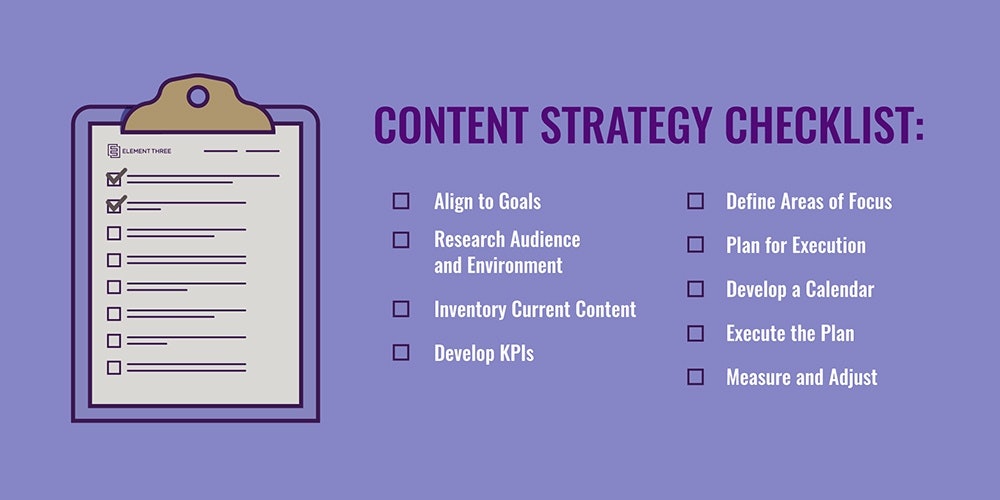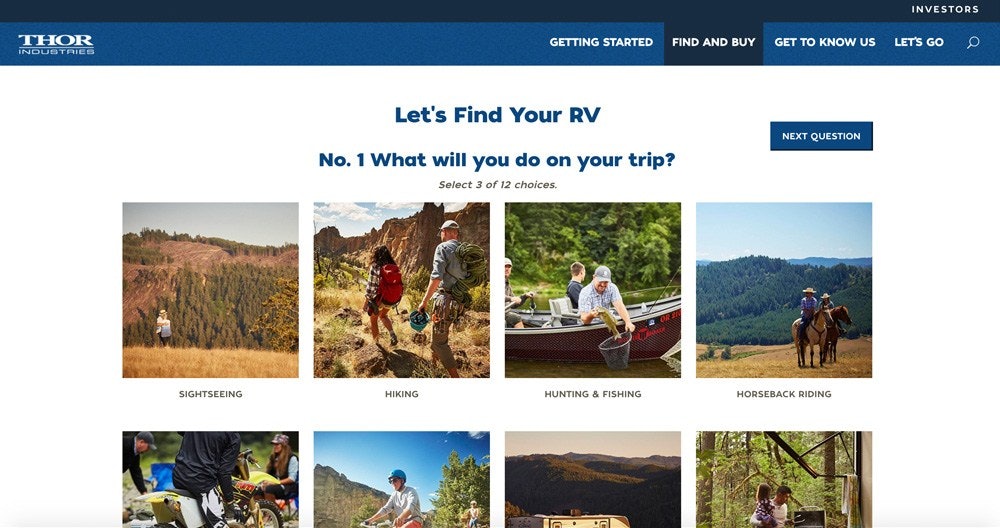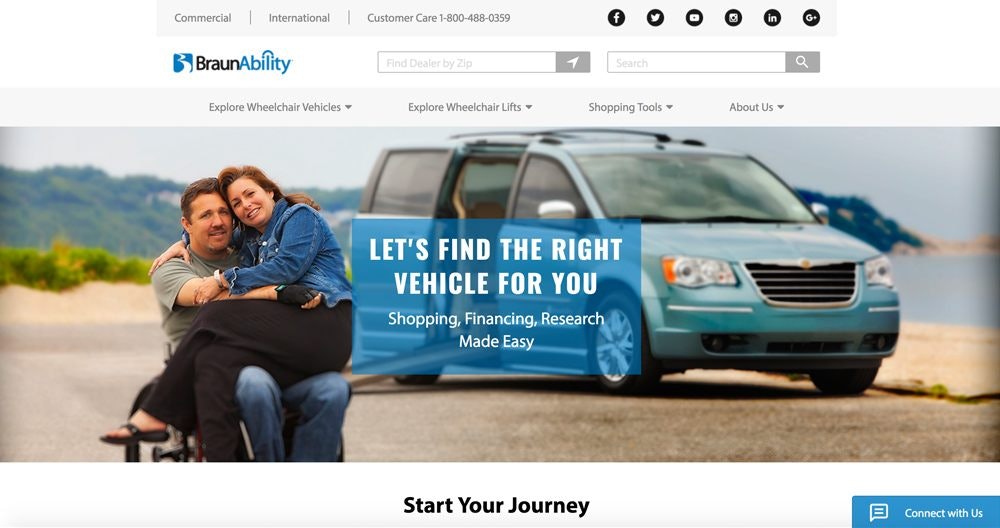So it’s 2017, and your marketing is underway. You’ve done your budgets, your forecasts and prognostications, said your prayers, and there’s nothing left but to get to it. Your epic Content Strategy awaits.
In this blog post, we’ll examine a common formula for creating a complete content marketing plan, diagnose some roadblocks, and finally look at future technologies and advanced techniques to make a run-of-the-mill strategy extraordinary. Here’s what you should consider to take your 2017 content strategy to the next level.
The Checklist
Are you ready for the easy part? A content strategy for your brand – online and off – isn’t exactly rocket science. The formula for creating a marketing plan for your website and other content is pretty tried and true: identify some goals, do some research, create some themes that address your biggest strengths and opportunities (or weaknesses and threats), and put together an action plan to create, launch, test, and adjust.
Still, the exercise of running through a checklist can be a handy starting point before we get to the next level analysis, tools, and techniques to make it shine. Even if you’re an old pro at this content marketing thing, there might be a handy definition or new, cheap software here to save you some tears or some time.
Let’s take a quick dive into the meaning of each step, and any tools to help your process along.
Align to Goals
There is really only one reason to do a content strategy – to meet a company goal. Your organization’s goals can vary, and depending on the variance, you may need a singular strategy or multiple strategies. Look at your organization’s goals and the role marketing plays in addressing those goals. If an increase in revenue tied to new sales is one such goal, you can develop a strategy for your content to align to and assist that goal.
Be specific – in fact, if you can identify a SMART goal or transform the chosen goal into a SMART one, that will come in very handy – particularly in proving the ROI of your marketing efforts. Using the above example, you can identify the goal that your strategy aligns to as “Increase Sales attributed to Website Leads by 20% during 2017, as compared to 2016’s lead total.” That’s a wonderful goal to build a content strategy around!
Pro Tip: Utilizing a business intelligence tool like Domo can help you not only analyze past performance and tracking towards goals, but can help you forecast and plan accordingly for the future.
Research Audience and Environment
With your goal identified, you next should take a look at who your target audience is, and what kind of content is available to them to answer their questions or solve their problems. You will want to start with your end customer in mind, and analyze what steps are necessary to get them to take a desired action – in the case of our ultimate goal above, become a website lead.
Next, identify what’s available to the audience, generally speaking. What methods of advertising, communication, problem-solving and the like are available to them? How do they prefer to be communicated to? What’s effective? Are there any market factors likely to change these behaviors and channels of communication?
Pro Tip: Use an online data analysis tool like Buzzsumo to search by topics, and see what articles and influencers have been most popular. This can help you identify content your audience has enjoyed or found helpful around a specific topic.
Inventory Current Content
Following your audience analysis, you’ll need to identify the strengths, weaknesses, opportunities, and threats of your content and that of your competitors. Keep in mind to consider who your customer considers as competitors, today and in the future. This can differ greatly depending on medium (online vs. offline, e-commerce vs. brick and mortar, etc.), geographic location, and other factors.
You can be as exhaustive or general as needed here. More information will allow for more targeted tactics and specific information to build upon, but at some point, you need to follow your instincts, pick a direction, and go with it.
Develop KPIs
How will you and others measure success? This should be tied back to the goal that your strategy is aligned to. If, as in our example above, website lead generation is your goal, you may decide to develop a few means of improvement, such as “increasing web traffic” and “increasing newsletter to prospect conversion rate.”
These can (and probably should) be mini-SMART Goals that support the overall goal. You may need some ramp up time, such as time for content development or hiring and training new staff. Being detailed here will help you track progress throughout your annual strategy.
Define Areas of Focus
How, specifically, are you going to meet your KPIs, and how are they addressing your opportunities or weak areas of content? Some of your focus can and should be defined by your goals, your audience, and all the steps you’ve taken up to this point. Again, align upward through your previous steps to create these areas of focus. They could be audience-focused, product-related, or other means of alignment.
In our example goal of web leads, via increased web traffic and newsletter-to-prospect conversions, you might decide to focus in three ways:
- Paid Digital Campaign (drives traffic)
- Marketing Automation for New Contacts (newsletter to prospect conversions)
- Audience Question Content Hub (solves problem to convert contact to prospect)
The example above is likely an over-simplification, but is useful for demonstration of the idea – think through your KPIs, your audience’s needs, and the market opportunities or areas where you can approve, and diagnose here what you’re going to do to address those themes.
Plan for Execution
Next, you need to identify what resources you will need to implement your strategy. Who’s going to do what? What assets do you need to create? What software, systems, and other technological concerns are involved?
Many will skip this step (and potentially the next) right to execution – but the plan for how you’re going to achieve your goals is just as important as what is going to achieve your goals. Be sure to consider all of your resources – ad spend, content creation, reporting, etc. – before you get started. Your diligence here will help you plan your next moves.
Develop a Content Calendar
Easy enough. Consider resource capacity, seasonality, and immediate organizational needs and priorities, and outline your monthly plan of publishing new content developed within your strategy. Set deadlines and due dates, and be sure to include review and revamp times.
Execute the Plan
Once you’ve got your calendar developed, it’s time – finally! – for the rubber to meet the road. Get started on your first project – you’re done and ready to conquer the world! Aren’t you?
Measure and Adjust
If you really want your content strategy to be successful, you will need to measure the results of your efforts – not at the end of the year, but incrementally. Measuring incrementally affords you the opportunity to adjust in-stride, rather than arriving at the finish line with the goal unachieved.
You’ve worked hard to earn your marketing budget, and worked hard to put together this strategy. Don’t blow your chance by thinking you’ve got it all figured out, though. Being agile and responding to data and trends truly makes the difference between what makes a strategy look exceptional versus merely “good enough.” You may luck into the perfect strategy out of the gate, but more likely you will need to move and adjust a thing or two along the way to truly optimize your campaigns to meet the end goal. After all, as no battle plan survives contact with the enemy, no marketing plan survives contact with the customer.
Pro Tip: A digital optimization tool, such as landing page optimization software like VWO, helps with measuring the conversion rate of your page and allows you to test variants and their impact on conversions.
DETOURS AHEAD: How to Navigate Potential Roadblocks
There’s a wide range of factors that can cause your plans for content strategy excellence to waver. Identifying a few of these and planning accordingly when they arise can be the difference between staying on point and falling behind.
Unclear Goals
One of the biggest challenges can be having unclear goals – whether from Marketing, Sales, or even at the Organizational level.
The solution to this is simple: embrace your inner Stephen Covey and be proactive. Set your own specific goals. Identify what you can at the organizational level, and work from both the top down and the bottom up until you can trace a line from the organizational down to your marketing activities.
I won’t claim that this is easy – it can be quite challenging – but even in the absence of clear goals, you should be able to use your analytics programs and reports on marketing activities to review past performance and identify trends to help you forecast goals and KPIs for your marketing efforts. In a way, you get to set the agenda and the baselines by which you’ll be measured. This type of activity not only helps you prove the value of your content strategy and marketing efforts, but can also help the organization become more effective as a whole.
Organizational Shifts
Even if you are blessed with an organization that has very clear goals outlined, that does not mean there are no goal-related challenges ahead. Just as you need to be agile with your strategy and adjust to consumer behaviors and other market factors, so too does the organization.
A new product launch, an updated feature, a retired service offering, a new branch location – all these and more can be reasons why you’d need to revisit and adjust your overall strategy, or develop an addition or even separate strategy.
Brand mergers and company acquisitions are also major game changers. Even in the midst of an established brand strategy for consolidation of companies and a unified front of communications moving forward, new mergers and acquisitions can be made. These can change everything from the collateral and content assets you have at your fingertips all the way up to the driving organizational goals that you based your content strategy around.
If you approach these challenges with open arms and mind, you’ll be that much better of a content strategist for it.
Too Much To Do (Or Not Enough)
One of the biggest challenges for marketing departments can be prioritization. This is a challenge that ultimately should be identified – and addressed – in your content strategy’s planning phases. But even the best-planned strategy can’t overcome the loss of resources – or even the addition of new ones.
Capacity issues affect every team. Often new or shifting priorities will affect pre-planned work, and even something as important and thoroughly thought-out as your strategy is impacted. Things are going to happen. You need to decide where the give and take is, and adjust to make up what’s lost in the wake of changes.
Likewise, don’t neglect the opportunity to adjust based on increased resources. Nothing is more impressive than adjusting your KPIs and goals upward in an effort to not only take advantage of new resources, but to properly apply and align them with your strategic plan.
Short-term vs. Long-term Thinking
This one can again be impacted by outside factors – leadership, management, even market factors – and should again be identified in the planning stages. Most likely, you may run into this challenge during the approval of your strategy by key decision makers in your organization.
You need to ensure that you align quick wins with appropriate tactics, and set up long-term plans with the appropriate forecasts for future impact. Not everything can or has to have a direct, numerical KPI (although those are hard to argue with), but showing how longer-term plans break into easy-to-understand steps that clearly move the organization goals forward is crucial.
Balancing your strategies between work that generates immediate results and work that pays off in the long run is important. Be sure to identify opportunities to do both, and present accordingly.
New Opportunities or Threats
One final roadblock to prepare for is new opportunities or threats that will inevitably crop up. Be they new competitors, changing market conditions, new technologies, or other factors, the environment your business and your customers are operating in changes daily.
Stay ahead of the competition with your analytics tools and trends analysis. Use these tools to identify new opportunities. Build budgets into your strategies that address these concerns, as well as a plan for spending that budget if such disturbances do not occur.
Expert Considerations
So you’ve planned, you’ve pitched, you’ve crossed off the steps on the checklist and prepared for any roadblocks or smashed down the ones in your way. You’re ready to dominate. But how do you truly make your company stand out from the crowd?
Here’s a list of considerations that can make your work truly exemplary.
How Has Content Strategy Changed?
New technologies and devices are changing the way we plan and deliver content. Most Americans hold a supercomputer in their hands every day, complete with voice command search capabilities from a database that understands content, human sentiment, and more. You ask for “Chinese restaurant near me” and it knows to direct you to the 5-star, mid-priced joint down the street, and give you other options based on the ratings of others. Once you’ve picked your dinner spot, it can even get you there quicker, avoiding the traffic issues in your immediate area.
Talk about powerful. So how does your website compare?
Taking into account how people are interacting with your content – print or digital, organic or advertisement – is essential in reaching them. You have got to be modern and focused in your delivery.
Personalization and delivery on the medium of choice are just one means of reaching your audience in a better, faster, more meaningful way. You might think that your buyers aren’t using this “new-fangled” tech, but you’d be wrong.
Thor Industries leads the way with their new responsive website – and they didn’t stop the mobile friendly content with just the homepage and blogs. They designed a fully interactive Find Your RV tool to help users young and old find the right type of recreational vehicle for them. The result was a 50% year-over-year increase in mobile traffic in Q4.
Your content strategy must consider what methods of delivery your audience needs. If you’re not making it easy for them to interact with your content…they’re not going to interact with your content. Keep that in mind as you develop your strategies, and plan accordingly.
The Road Less Traveled
Can you believe that some organizations are still slow to adopt digital technologies as a significant channel of advertising? Some digital platforms have risen and fallen well before they arrive on organizations’ radars as a valid means of communication with customers, while others still remain incredibly vibrant and yet still underground (I’m looking at you, Reddit and Quora).
Yet PricewaterhouseCoopers estimates that online advertising is expected to overtake television in 2017. So while old school executives may still be listening to Forbes’ neuro studies on how print ads require less cognitive effort to process than digital, I’d recommend you listen when the millennial in your team takes out his or her headphones long enough to tell you about a new Facebook ad type they want to try.
Airstream did. When launching their new Basecamp travel trailer model in September of 2016, the legendary RV brand took a chance on a new Facebook ad type, Canvas ads, and the results were staggering.
For October, Airstream’s Canvas ad drove nearly identical traffic to the email channel, and almost 60% as much as organic search – all at a cost per click of pennies. You read that right. Pennies. Under a nickel cost per click rates, and it converted, too. For an important product aimed at attracting a slightly younger audience, this new Facebook channel provided exceptional value and return for the organization.
It was untested and untried. But the gamble – at a small portion of ad spend – paid off. This type of ad is now in the toolbox of the organization and our agency, and the opportunity to pitch new ideas is something everyone is on the lookout for.
The lesson? Be on the lookout for new technologies. Try something outside the box. The road less traveled isn’t always paved in gold, but the risks can sometimes pay off in a big way, if planned for and taken strategically. Look for new ways of targeting, virtual reality, and other smart technology improvements to continue to push the envelope in how we can reach our customers.
Experience vs. Outcome
Brand managers know it’s about more than just the product. Marketers need to develop this mindset, too. As our technology continues to not only increase our access to immediate information, but immediate interactions as well, our marketing efforts must include materials that build an experience, rather than merely suggesting an outcome.
What I mean by that is this: consumers buy goods more often based on the total experience – before, during, and after purchase – than just during and after purchase. It’s more than just kicking the tires, taking a test drive, and taking it home. The work, effort, and energy that consumers put into the pre-decision making process is steadily increasing.
Add to this the constant increase in signal heading our way, through social media, consumer reviews, customized music programs, online video, digital advertising, and more, supplementing (in some cases supplanting) our traditional television and print media content digestion, and all of a sudden it’s easy to get lost in the mix.
What can you do to stand out from the pack? Get amazingly creative people to do amazingly creative things, at the right time and the right place. You very likely have parameters you can’t violate within your strategy – a website that can’t be redesigned, a budget that doesn’t afford all the bells and whistles, a timeline that that is less than ideal.
Beat these challenges with creative thinking, and good creative work. Create what is needed with the resources you have. But make sure that whatever you create, you’re building it with your end consumer in mind.
That’s what BraunAbility did. When they needed a new way to simplify a complex information-gathering and buying process, they created a new mobility van content hub to help users educate themselves – no matter what part of the education process the end user was in. Creating content in this way lets a user self-select what information they need, rather than following what a marketer might guess is the best path forward.
It was a big step forward to solving problems and answering crucial questions for their customers. It delivered on their brand standards, enhanced the experience of using their website, and paved the way for solving prospects’ issues quickly and efficiently – delivering a meaningful, delightful experience.
These are just a few examples of how taking risks or seeing things from a new perspective can really shake up an ordinary content strategy, and add some much-needed excitement and freshness that can help power the rest of the strategy forward, both from an internal buy-in and external results perspective.
Wrapping It Up
We’ve learned an easy planning and execution process for creating a dynamite content strategy in 2017, led by research and forethought and driven by organizational goals. You’ve got an idea of what challenges might crop up during your planning and execution phases, and hopefully we’ve given you some ideas to mix it up and create some fresh and exciting content and outcomes.
Because the results speak for themselves. Planning first before you jump ahead is key to a good content strategy. Staying agile and rejecting fear of the new is how you make it great. Letting creative drive it to the next level – well, that’s something that’s going to make 2018’s content strategy even better.








